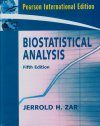Textbook
By: Jerrold H Zar(Author)
756 pages, b/w illustrations, tables
Zar: essential biostatistics textbook
![Biostatistical Analysis (International Edition) Biostatistical Analysis (International Edition)]()
Click to have a closer look
About this book
Contents
Customer reviews
Biography
Related titles
About this book
An introductory textbook as well as a useful reference work, Biostatistical Analysis presents a broad collection of data analysis techniques which will address the statistical needs of the great majority of contemporary biological researchers.
Contents
1. Data: Types and Presentations
2. Populations and Samples
3. Measures of Central Tendency
4. Measures of Variability and Dispersion
5. Probabilities
6. The Normal Distribution
7. One-Sample Hypotheses
8. Two-Sample Hypotheses
9. Paired-Sample Hypotheses
10. Multisample Hypotheses and the Analysis of Variance
11. Multiple Comparisons
12. Two-Factor Analysis of Variance
13. Data Transformations
14. Multiway Factorial Analysis of Variance
15. Nested (Hierarchical) Analysis of Variance
16. Multivariate Analysis of Variance
17. Simple Linear Regression
18. Comparing Simple Linear Regression Equations
19. Simple Linear Correlation
20. Multiple Regression and Correlation
21. Polynomial Regression
22. Testing for Goodness of Fit
23. Contingency Tables
24. Dichotomous Variables
25. Testing for Randomness
26. Circular Distributions: Descriptive Statistics
27. Circular Distributions: Hypothesis Testing
Appendix A: The Greek Alphabet
Appendix B: Statistical Tables and Graphs
Appendix C: The Effects of Coding Data
Appendix D: Analysis of Variance
Hypothesis Testing
Answers to Exercises
Literature Cited
Author Index
Subject Index
Customer Reviews
Biography
Jerrold H. Zar received his undergraduate degree in Biological Sciences from Northern Illinois University in 1962. He later earned his M.S. and Ph.D. degrees in biology and zoology from the University of Illinois at Urbana-Champaign. Then, Zar returned to serve Northern Illinois University for 34 years in a variety of capacities. He joined the faculty at NIU as an Assistant Professor in 1968 and quickly rose through the ranks of Associate and Full-time Professor to become Chair of the Department of Biological Sciences in 1978. He served two terms as Chair of the Department and then, became the Vice-President for Graduate Studies and Research as well as the Dean of the Graduate School. He is a founding member of the Illinois Minority Graduate Incentive Program and the Illinois Consortium for Educational Opportunities Program where he helped create and protect fellowship opportunities for minority graduate students at NIU and across the state. Zar is a member of 17 professional scientific societies, including the highly regarded American Association for the Advancement of Science. His fields of interests include statistical analysis of biological data and the physiological adaptations of animals to their environment.
Textbook
By: Jerrold H Zar(Author)
756 pages, b/w illustrations, tables
Zar: essential biostatistics textbook



































